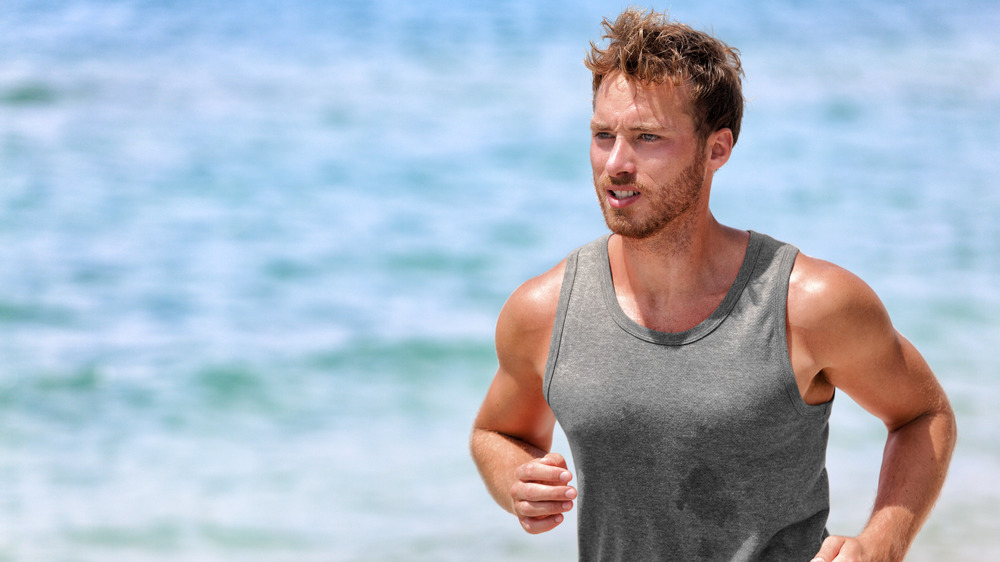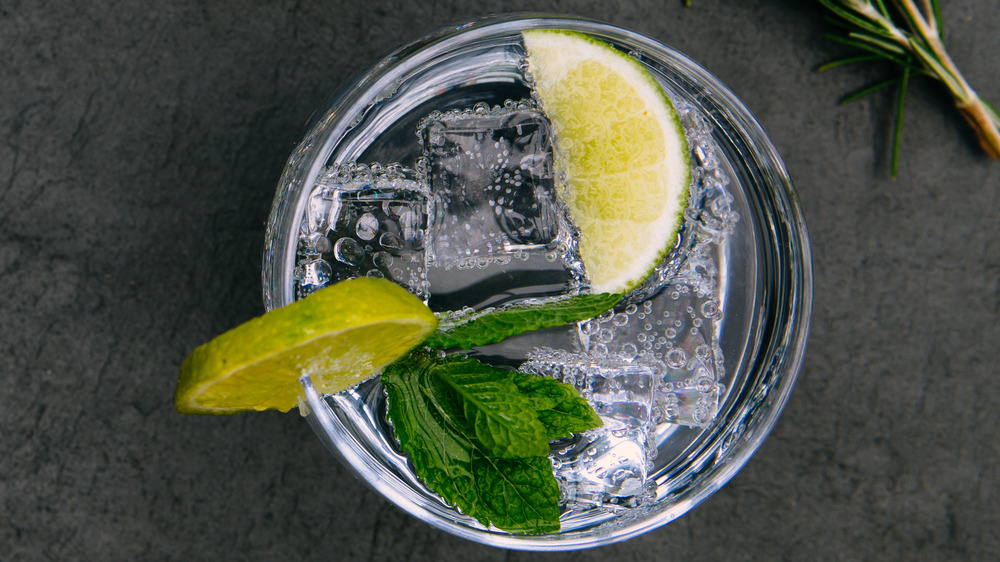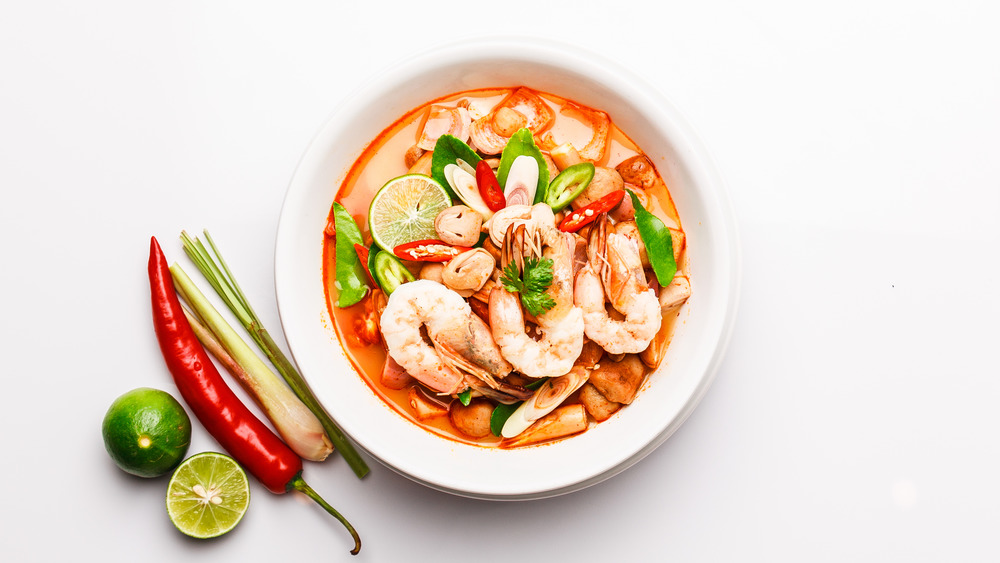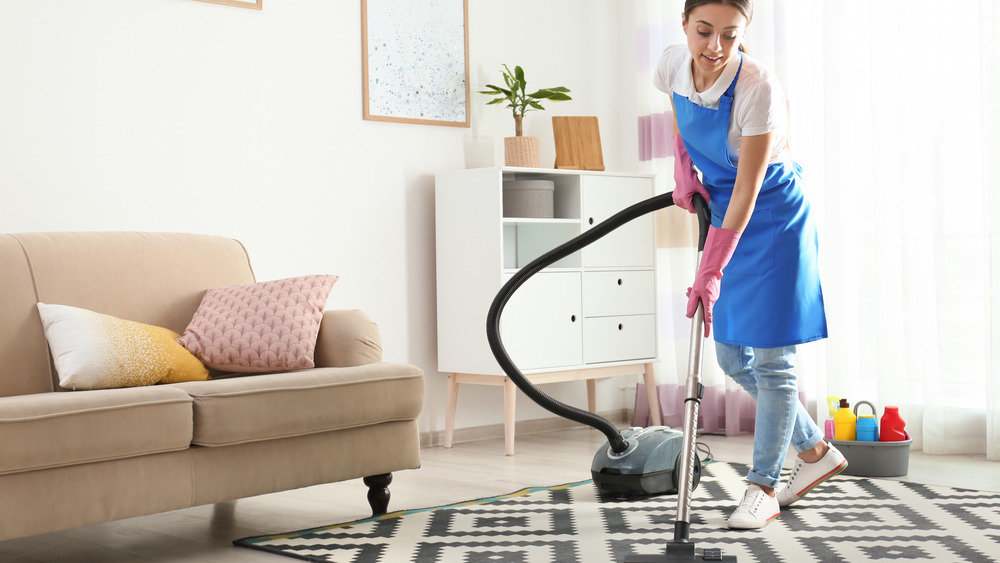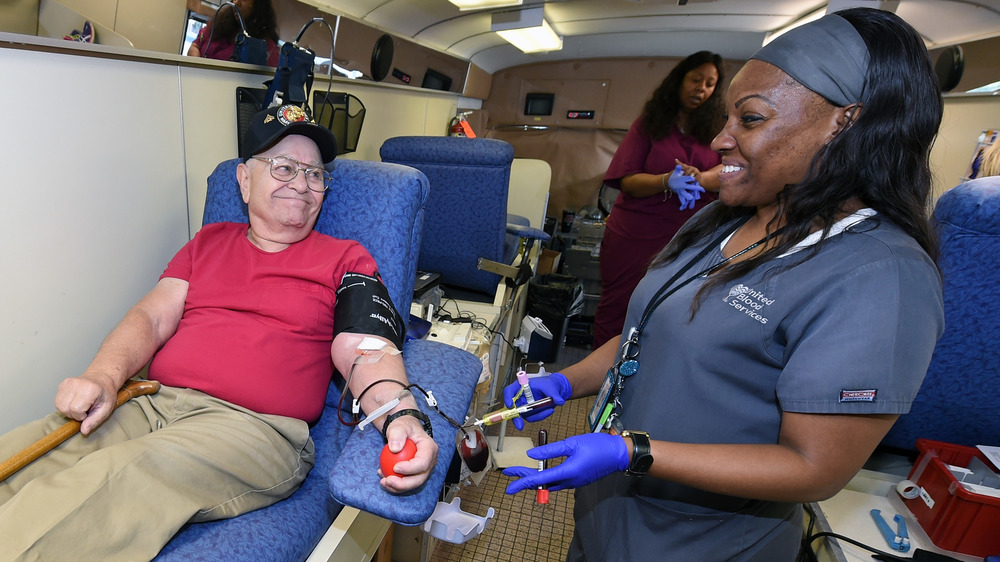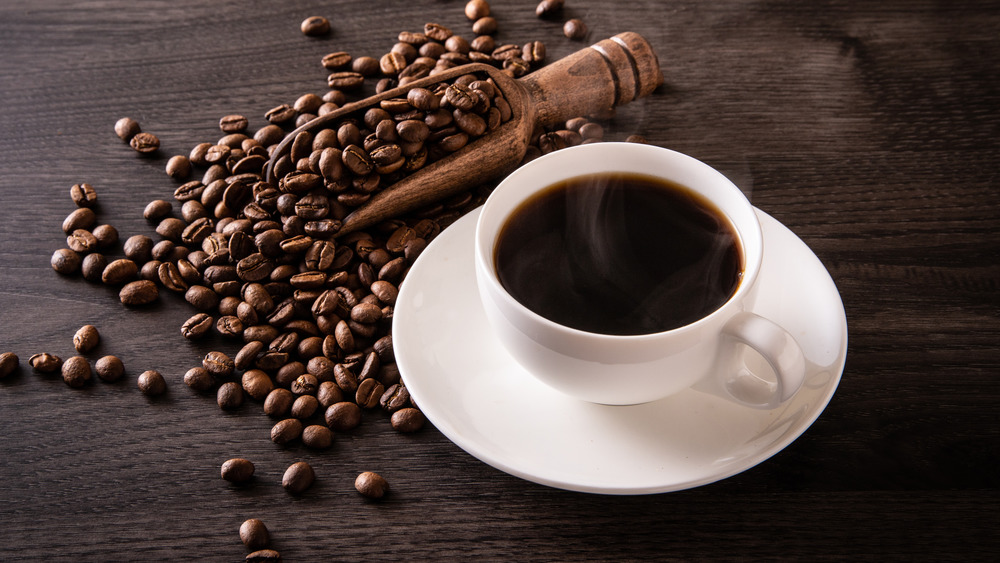Strange Things You Didn't Know Helped You Burn Calories
When you think of burning calories, you might picture an intense workout, but the calories you burn during exercise are actually just a small slice of your total daily energy expenditure, which is how many calories you burn in a 24-hour period (via Verywell Fit).
You see, whether you're sleeping or you're running a marathon, your body is always hard at work keeping your systems running and supplying the necessary energy to your working systems and muscles. In fact, the energy your body uses just to breathe, keep your heart beating, employ cellular turnover, and support brain function are actually quite significant.
As pointed out by Verywell Fit, you add to your basal metabolic rate (the calories you burn at rest) by performing non-exercise activity like fidgeting, digesting and assimilating food, and, of course, hitting the gym to break a sweat. So if you're looking to boost your daily calorie burn, pumping up your exercise routine will certainly pay off, but you don't want to overlook other ways to amp up the burn. Consider these surprising and strange things that help burn calories.
Exercising in hot weather melts calories
You probably know that running a few miles is a good way to burn calories (although the specific number of calories varies from person to person based on factors like age, muscle mass, running speed or intensity, and weight), but did you know that the weather you work out in makes a difference in how many calories you burn?
Think about it: Exercise is a form of stress you're placing on your body, and your body's systems have to respond to this stress by delivering more energy to your working muscles. When you exercise in hot weather, you're adding to the stress of your workout because, according to the American Council on Exercise, your body has to work harder to cool itself down.
If your body's core temperature naturally increases with the stress of exercise and it responds by initiating sweating to help you stay cool, your body has to work even harder to sweat more if you're exercising in a hot environment. The catch, of course, is that working out in hot weather is, well, hard and uncomfortable — so you may not be able to work out as long without acclimatization (through practice and time).
Shivering isn't fun, but it does burn calories
Similar to hot weather, cold weather can help you boost your calorie burn during a workout or throughout the day. But there's a catch. Most people bundle up to feel comfortable when they head out into the cold. This makes sense, of course, as not many people really enjoy feeling cold. Without the appropriate clothing, your body will work to increase internal heat through shivering — and that significantly increases calorie burn.
A 2014 study published in Cell Metabolism examined the metabolic response to cold exposure and found that individuals who rested (yes, rested!) while wrapped in thermoblankets that were cooled from an initial 80 degrees Fahrenheit to 53 degrees Fahrenheit saw an increase in calorie burn by 48 percent, with those who started shivering seeing the greatest increase in calorie burn and associated muscle activity (via National Institutes of Health).
Now, that doesn't mean you should step outside in a tank top in the middle of winter. "Exercising in cold weather increases the risk of hypothermia (abnormally low body temperature)," Harvard Men's Health Watch explained. In fact, "intense shivering" should prompt you to seek emergency medical attention.
Drinking cold water burns more calories than drinking room temperature water
Just as hanging out in the cold can boost your calorie burn, so, too, can drinking cold water. However, the boost is minimal, so it's certainly not a fast path to weight loss success. Studies on the thermogenic effect of drinking water (the calorie burn associated with assimilating water into your system) show there is some evidence that the colder the water you drink, the harder your body has to work to cool it to body temperature while assimilating it (via Verywell Fit). However, "most of the energy expenditure seems to come from the body working to balance fluid, salt, and sucrose levels after the influx of extra water," according to Verywell Fit.
One study in The Journal of Clinical Endocrinology and Metabolism, found that participants who drank water cooled to 37 degrees Fahrenheit burned about 15 more calories per water bottle. This means that if you drink two liters of chilled water per day, you could potentially burn an extra 60 calories. Plus, ice cold water typically tastes better, and staying well hydrated is a good way to keep your body's systems running on all cylinders.
Spicy foods will have you feeling the burn
If you've ever eaten something extra spicy and found yourself sweating and sniffling (and maybe jumping up to pace around as you seek out a glass of ice cold milk) while attempting to combat the heat, you've witnessed your metabolism kicking into high gear. In an article for Greatist, Douglas Kalman, a registered dietitian, confirmed that yes, science does seem to indicate that spicy foods — particularly foods with peppers containing capsaicin — can increase calorie burn during and following eating. Interestingly, a study cited by Kalman found that those who ate meals with added spice also consumed fewer calories during the meal.
However, the more spice people consume on a regular basis, the less potent the calorie-burning effect becomes. This means that adding some heat to your favorite meals a couple times a week may help you blast a few extra calories, but if you're loading up every meal with red hot peppers and become desensitized to them, you're probably not enjoying a major increase in calorie burn.
Sleeping can lead to burning calories
To be clear, sleep doesn't directly increase calorie burn. Even though your body does continue burning calories while you sleep (your brain and organs keep working, after all), you're burning fewer calories than in your waking hours. That said, according to the National Sleep Foundation, chronic sleep loss is associated with weight gain, not weight loss.
Burning the candle at both ends and zipping around all day every day isn't doing your body good. This appears to be in part due to the chemical changes that take place when you don't get enough sleep, causing you to feel more hungry, and possibly fail to recognize "full" feelings while eating, ultimately leading to an increase in calorie consumption (via National Sleep Foundation). Plus, if you're well rested, you're more likely to have the energy to hit the gym and stick to a regular workout schedule.
So while sleep itself may not increase calorie burn, getting enough sleep on a regular basis helps keep your body ticking the way it's supposed to, providing you with the energy necessary to stay active and consume a healthy, well-balanced diet. In turn, this may help you burn more calories each day.
Fidgeting and moving around a lot is a neat way to burn calories
If you have a hard time staying still — your feet are always tapping or you're always "puttering" around the house — you'll be happy to learn that this nervous activity can add up when it comes to burning calories. The official term for this type of fidgeting is non-exercise activity thermogenesis (NEAT).
Mayo Clinic researcher Dr. James Levine, who is at the forefront of studying NEAT, has stated that this type of activity can account for differences in calorie burn of up to 2,000 calories per day in people of similar sizes (via Harvard Health). His research has found that lean individuals (even those whose jobs are sedentary) tend to stand up and walk around for several more hours a day than obese individuals.
If you're looking to burn more calories, just moving around can pay off. Instead of sitting and watching your kids' extracurriculars, stand on the sideline or walk around the facility as you watch. Or while at work, use a standing desk or arrange to take walking meetings with your coworkers.
Laughing away calories is actually possible
Laughter is the best medicine, right? Not only does it lift your mood and boost happiness and connection with those you're laughing with, it can also burn calories. If you've ever laughed until it hurt, you can probably understand why laughter burns calories — a serious belly laugh is practically a full-body exercise.
In a study led by Dr. Maciej Buchowski, one of Vanderbilt University Medical Center's researchers, it was found that laughter increases heart rate by 10 to 20 percent, which can account for an increase in calorie burn of about 10 to 40 calories if the person laughs for 10 to 15 minutes each day (via Reporter).
Granted, 10 to 40 calories per day isn't a huge increase, but it is an easy increase — with no treadmill required. To amp up your calorie burn, go ahead and put on your favorite Netflix comedy or set a time to hang out with your best friends. You'll still need to make time for exercise, but calories burned from laughter is like icing on the cake.
Cleaning your house burns more calories than you might expect
Cleaning your house is a great way to rack up some NEAT (non-exercise activity thermogenesis) in your life. Activities like vacuuming, mopping, and scrubbing surfaces can burn about 4 calories per minute, personal trainer Malia Fray explained in an article for Verywell Fit. If you end up cleaning your house for an hour each day, that can add up to about 200 calories burned. And if your house has stairs? Every minute you log walking up and down those steps to, say, deliver clean laundry to your kids' rooms or lug cleaning supplies between your two floors, you'll burn 6 extra calories. And while, sure, you want your cleaning routine to be quick and efficient, being a little less efficient can lead to more calories burned.
By switching up your routine and cleaning one room upstairs, then one room downstairs, then moving back upstairs again, you'll add a little more activity without adding too much time to your cleaning routine. Or you can switch to washing dishes by hand rather than throwing them in the dishwasher. Little changes can add up over time.
Exercising on loose sand will help you burn more calories
If you're looking to boost calorie burn during your workout routine, hitting the beach (or a local sand volleyball court) can be a good option. Certified strength and conditioning coach, Janet Hamilton told LiveStrong that running on a soft surface, like sand, boosts calorie burn because the ground reaction force (the "pushback" of the ground against your foot when you run on a hard surface) is diminished, forcing you to work harder to take each step.
As highlighted by Livestrong, a study in the Journal of Experimental Biology found that running on sand may increase your calorie burn during your workout by 1.6 times — but there are a few things to consider. First, there will be a difference in the calorie burn increase between hard, packed sand and loose, dry sand. The looser the sand, the greater the give, and the greater the increase in calories burned. But the other side of the coin is that the more challenging the workout, the more likely you won't be able to push yourself as long as you would on a harder surface, like a road or even firm sand. So while you may burn more calories minute over minute at the same intensity level, your typical workout length may be cut short.
Your body will burn more calories when running trails as opposed to roadways
Want to burn more calories? Consider switching from road running to trail running. The thing to remember is that calorie burn, especially as it relates to exercise, is a reflection of the stress you're placing on your body. When your muscles, tendons, and ligaments need to move and react in ways they haven't before, this new stimulus is going to require more brain-body engagement and muscle firing that ultimately requires more energy (via Shape). And when you're running on a trail full of divots, roots, hills, and rocks, you're forced to take steps in every direction and alter your gait in ways that normal road running doesn't require.
As certified strength and conditioning coach Bob Seebohar told Shape, "Anytime you transition from road and smooth pavement to trails and undulating terrain, there's more stress on the body and mind. The terrain is uneven and the verticals typically steeper, so you'll burn more calories." But, take it slow as you make the transition and don't expect to hit your same mile-per-hour pace at first — trail running is typically harder.
Donating blood burns a significant amount of calories
If you're looking for a way to just lay there and burn more calories, it might be time to check your community health sites for blood drive dates and locations. While it may be a bit surprising, donating blood can boost calorie burn for a short period of time following your donation (via Medical Daily).
Wondering how this could be? When you donate blood, you're (obviously) sacrificing a part of your body for someone else, and in order to replace your own blood volume to pre-donation levels, your body has to get to work to create new blood cells and proteins, according to the U.K.'s National Health System. And whenever your body is charged with firing up and generating new cells, your metabolism kicks into gear, thus increasing calorie burn. Interesting, donating blood has been found to burn 600 calories (via Saint Mary's Medical Center).
That said, donating blood is not a lose-weight-fast, calorie-blasting plan. Because you're literally removing an important part of your system when you donate blood, you need to give your body time to recuperate. According to the American Red Cross, you should wait at least eight weeks between blood donations.
Breastfeeding is an incredible calorie-burner
You probably know that a pregnant woman should consume more calories when she's pregnant due to the extra calories she burns every day while growing her baby (via Eat Right). But what you might not realize is that breastfeeding burns even more calories than pregnancy. Just think about it — every single day that a new mom breastfeeds, her body is responsible for generating more milk for her baby. All that milk generation is tough work! According to Healthline, breastfeeding moms tend to burn about 500 extra calories per day while producing breast milk.
Of course, breastfeeding moms should be consuming enough calories to help support milk production, so it's not like breastfeeding is a quick and easy weight loss plan. That said, the site emphasized that moms who choose to breastfeed during the first six months following birth tend to lose more weight than those who exclusively formula feed."If you're planning to lose weight, you'll want to follow a healthy diet and exercise routine in addition to breastfeeding," Healthline advised. "The combination should result in a quicker slim down than breastfeeding alone."
Burn calories by consuming caffeine
If you avoid coffee or other sources of caffeine because you've heard mixed information about their safety, well, we have some (good) news for you. A comprehensive 2017 review study looked at 201 different meta-analyses on caffeine intake and health found that "coffee consumption seems generally safe within usual levels of intake ... and more likely to benefit health than harm."
According to Healthline, consuming caffeine can increase your resting metabolic rate by 3 to 11 percent, although the greatest benefits are seen in younger, lean individuals, rather than those who are older or obese. And, as with consuming spicy foods, your body can acclimate to regular caffeine intake, so you're most likely to enjoy the benefits after taking a break from caffeine.
Plus, it's important to remember that you can negate any calorie burn you're enjoying if you're loading up on sweeteners and fats at the same time. Stick to black coffee or sugar-free caffeine options if you can.


